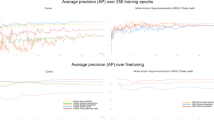Abstract
Objectives
We propose an augmented reality system for the reliable detection of root canals in video sequences based on a k-nearest neighbor color classification and introduce a simple geometric criterion for teeth.
Material and methods
The new software was implemented using C++, Qt, and the image processing library OpenCV. Teeth are detected in video images to restrict the segmentation of the root canal orifices by using a k-nearest neighbor algorithm. The location of the root canal orifices were determined using Euclidean distance-based image segmentation. A set of 126 human teeth with known and verified locations of the root canal orifices was used for evaluation.
Results
The software detects root canals orifices for automatic classification of the teeth in video images and stores location and size of the found structures. Overall 287 of 305 root canals were correctly detected. The overall sensitivity was about 94 %. Classification accuracy for molars ranged from 65.0 to 81.2 % and from 85.7 to 96.7 % for premolars.
Conclusion
The realized software shows that observations made in anatomical studies can be exploited to automate real-time detection of root canal orifices and tooth classification with a software system.
Clinical relevance
Automatic storage of location, size, and orientation of the found structures with this software can be used for future anatomical studies. Thus, statistical tables with canal locations will be derived, which can improve anatomical knowledge of the teeth to alleviate root canal detection in the future. For this purpose the software is freely available at: http://www.dental-imaging.zahnmedizin.uni-mainz.de/.




Similar content being viewed by others
References
Edwards P, King A, Hawkes D et al (1999) Stereo augmented reality in the surgical microscope. Stud Health Technol Inform 62:102–108
Tse B, Harwin W, Barrow A, Quinn B, San Diego J, Cox M (2010) Design and development of a haptic dental training system – Haptel. In: Kappers A, van Erp J, Bergmann-Tiest W, van der Helm F (eds) Haptics: generating and perceiving tangible sensations, 1st edn. Springer, Heidelberg, pp 101–108
Sutherland L, Middleton P, Anthony A et al (2006) Surgical simulation: a systematic review. Ann Surg 243:291–300
Thomas R, John N, Delieu J (2010) Augmented reality for anatomical education. J Vis Commun Med 33:6–15
Birkfellner W, Figl M, Huber K et al (2002) A head-mounted operating binocular for augmented reality visualization in medicine-design and initial evaluation. IEEE Trans Med Imag 21:991–997
Del Fabbro M, Taschieri (2010) Endodontic therapy using magnification devices: a systematic review. J Dent 38:269–275
Staudt C, Kinzel S, Hassfeld S, Stein W, Staehle H, Dörfer C (2001) Root canal morphology of permanent three-rooted mandibular first molars. Part 1: pulp floor and root canal system. J Clin Periodontol 28:746–752
J. Eberhart, M. Frentzen, and M. Thoms (2007) New method to detect caries via fluorescence. In: Schweitzer D, Fitzmaurice M (eds) Diagnostic Optical Spectroscopy in Biomedicine IV, Vol. 6628 of Proceedings of SPIE-OSA Biomedical Optics, Optical Society of America, Washington, paper 6628_21
Brüllmann D, Schmidtmann I, Warzecha K, d’Hoedt B (2011) Recognition of root canal orifices at a distance—a preliminary study of teledentistry. J Telemed Telecare 17:154–157
Krasner P, Rankow H (2004) Anatomy of the pulp-chamber floor. J Endod 30:5–16
Brüllmann D, Alvarez P, Willershausen B (2009) Recognition of root canal orifices in video sequences as a future support system during endodontic treatment. J Endod 35:1400–1403
Selvarasu N, Nachiappan A, Nandhitha N (2010) Abnormality detection from medical thermographs in human using euclidean distance based color image segmentation. IEEE Computer Society (ed) International Conference on Signal Acquisition and Processing, 2010. ICSAP '10, IEEE Computer Society, Los Alamitos, pp 73–75
Friedman J, Baskett F, Shustek L (1975) An algorithm for finding nearest neighbors. IEEE Trans Comput 24:1000–1006
Sun B, Du J, Gao T (2009) Study on the improvement of k-nearest neighbor algorithm. In: IEEE Computer Society (ed) International Conference on Artificial Intelligence and Computational Intelligence, 2009. AICI '09, IEEE Computer Society, Los Alamitos, pp 390–393
Knuth D (1998) The art of computer programming, 2nd edn., Addison Wesley, Bonn
Shim J, Dorai C (1999) A generalized region labeling algorithm for image coding, restoration and segmentation. In IEEE Computer Society (ed) International Conference on Image Processing, 1999. ICIP 99. Proceedings. IEEE Computer Society, Los Alamitos, pp 46–50
Jaehne B (2010) Digital image processing, 7st edn. Springer Berlin
Gu Y, Lu Q, Wang H, Ding Y, Wang P, Ni L (2010) Root canal morphologyof permanent three-rooted mandibular first molars. Part 1: pulp floor and root canal system. J Endod 36:990–994
de Menezes M, Rosati R, Ferrario V, Sforza C (2010) Accuracy and reproducibility of a 3-dimensional stereophotogrammetric imaging system. J Oral Maxillofac Surg 68:2129–2135
Rosati R, Menezes M, Rossetti A, Sforza C, Ferrario V (2010) Digital dental cast placement in 3-dimensional, full-face reconstruction: a technical evaluation. Am J Orthod Dentofacial Orthop 138:84–88
Wengert C, Cattin P, Du J, Baur C, Szekely G (2006) Markerless endoscopic registration and referencing. Med Image Comput Computer-Assist Interv 9:816–823
Acknowledgments
This article contains parts of the bachelor thesis of Henning Tjaden. Further, the authors declare that there are no conflicts of interest, nor financial relations to any commercial corporation or products.
Author information
Authors and Affiliations
Corresponding author
Electronic supplementary material
Below is the link to the electronic supplementary material.
(MPG 95854 kb)
Rights and permissions
About this article
Cite this article
Bruellmann, D.D., Tjaden, H., Schwanecke, U. et al. An optimized video system for augmented reality in endodontics: a feasibility study. Clin Oral Invest 17, 441–448 (2013). https://doi.org/10.1007/s00784-012-0718-0
Received:
Accepted:
Published:
Issue Date:
DOI: https://doi.org/10.1007/s00784-012-0718-0




